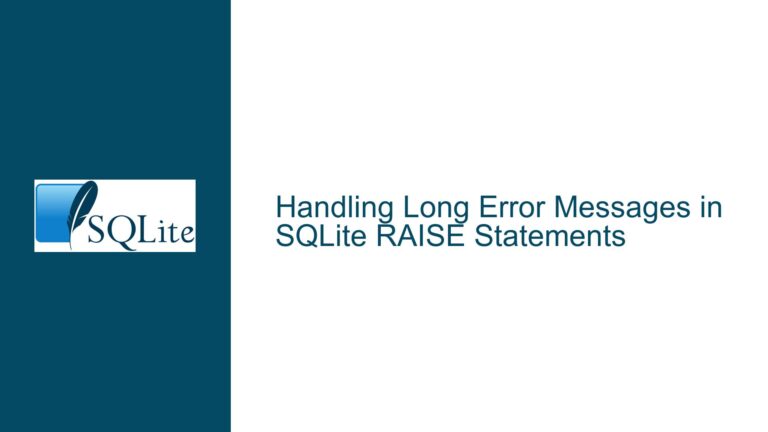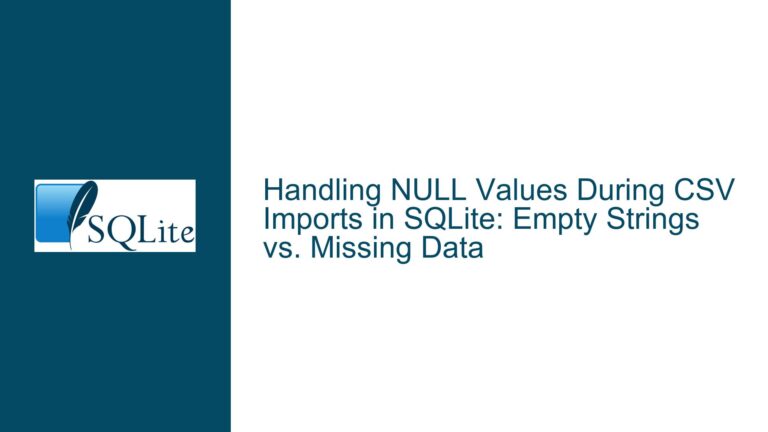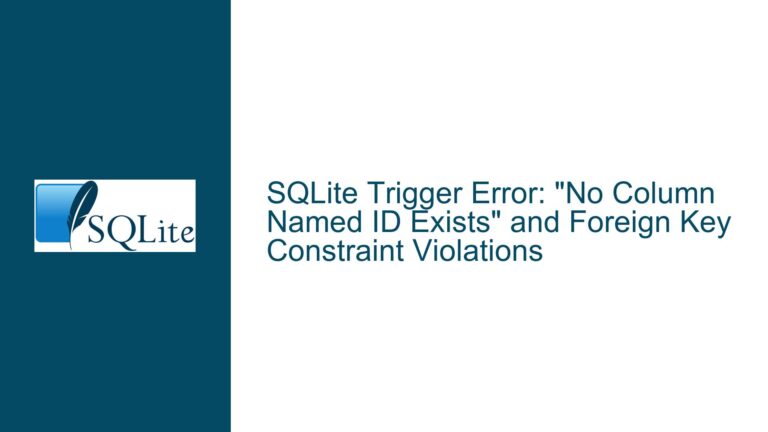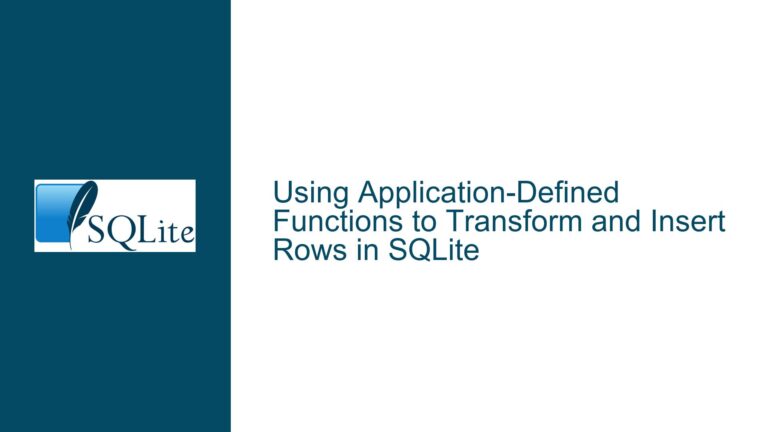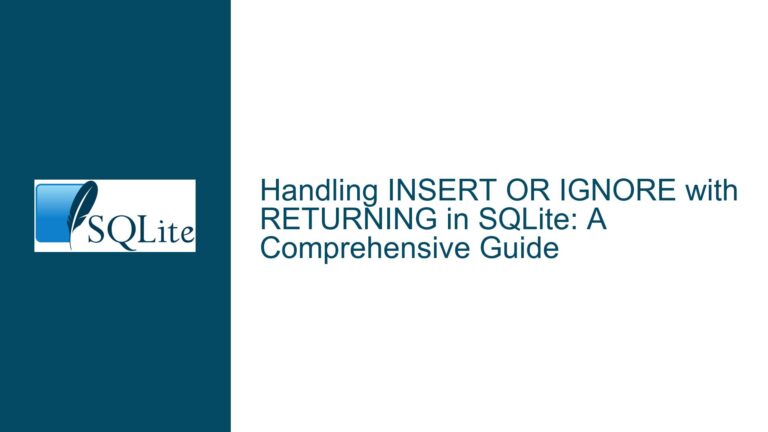In-Memory SQLite Database Not Saved via VACUUM INTO: Causes and Solutions
Understanding VACUUM INTO Failures with In-Memory Databases
Issue Overview: Silent Failure When Saving In-Memory Databases via VACUUM INTO
The problem arises when attempting to save an in-memory SQLite database to a file using the VACUUM INTO command. While the same operation succeeds when applied to an on-disk database, it fails silently for in-memory databases: no error is reported, but no file is created. The user’s code checks for errors incorrectly, interpreting the SQLITE_DONE status (a normal completion signal) as an error. However, even after correcting error handling, the VACUUM INTO command does not generate a file for in-memory databases. This behavior stems from fundamental limitations in how SQLite handles in-memory databases and the VACUUM command’s requirements.
Key observations:
VACUUM INTOworks for on-disk databases but fails for in-memory databases.- The error message
no more rows available(corresponding toSQLITE_DONE) is misinterpreted as a failure. - Resource leaks (unfreed statements, unmanaged strings) compound the issue.
Root Causes: Why VACUUM INTO and In-Memory Databases Conflict
Three primary factors contribute to this issue:
Misuse of
VACUUM INTOwith In-Memory Databases
TheVACUUM INTOcommand is designed to clone or rebuild the main database into a new file. However, when the main database is in-memory, SQLite’s internal implementation ofVACUUMcannot interact with it in the same way as a disk-based database. Specifically:- In-memory databases lack a backing file, making it impossible for
VACUUM INTOto resolve the target path relative to the main database’s storage. - Temporary or in-memory databases are excluded from certain durability guarantees and file operations, which
VACUUMimplicitly relies on.
- In-memory databases lack a backing file, making it impossible for
Incorrect Error Handling in Code
Thesqlite3_step()function returnsSQLITE_DONEwhen a command finishes successfully. The user’s code incorrectly treats any return value other thanSQLITE_OKas an error, leading to false positives. This misinterprets the normal completion status as a failure, creating confusion about whether the operation succeeded.Resource Management Oversights
The original code fails to:- Properly finalize SQL statements in all code paths (leaking memory).
- Free the string returned by
sqlite3_expanded_sql(), which must be manually released withsqlite3_free().
Resolving the Issue: Step-by-Step Fixes and Alternatives
To address the problem, follow these steps:
Step 1: Correct Error Handling for sqlite3_step()
Modify the code to recognize SQLITE_DONE as a success status for VACUUM operations:
int save_database(sqlite3 *db, const char *fn) {
sqlite3_stmt *stmt = NULL;
char *expanded_sql = NULL;
int rc = 0;
// Prepare the VACUUM statement
if (sqlite3_prepare_v2(db, "VACUUM INTO ?;", -1, &stmt, NULL) != SQLITE_OK) {
fprintf(stderr, "Prepare error: %s\n", sqlite3_errmsg(db));
rc = 1;
goto cleanup;
}
// Bind the filename parameter
if (sqlite3_bind_text(stmt, 1, fn, -1, SQLITE_STATIC) != SQLITE_OK) {
fprintf(stderr, "Bind error: %s\n", sqlite3_errmsg(db));
rc = 1;
goto cleanup;
}
// Debugging: Print the expanded SQL (remember to free it!)
expanded_sql = sqlite3_expanded_sql(stmt);
printf("%s\n", expanded_sql);
// Execute the statement
int step_rc = sqlite3_step(stmt);
if (step_rc != SQLITE_DONE) {
fprintf(stderr, "Step error (%d): %s\n", step_rc, sqlite3_errmsg(db));
rc = 1;
}
cleanup:
// Free resources
sqlite3_free(expanded_sql);
sqlite3_finalize(stmt);
return rc;
}
This revised code:
- Uses
SQLITE_DONEas the success indicator. - Properly frees the expanded SQL string.
- Ensures the statement is finalized even if errors occur.
Step 2: Avoid VACUUM INTO for In-Memory Databases
Since VACUUM INTO does not support in-memory databases, use one of these alternatives:
Option A: Use the Backup API
SQLite’s Backup API is designed to clone databases efficiently:
#include <sqlite3.h>
int save_database(sqlite3 *src_db, const char *fn) {
sqlite3 *dst_db = NULL;
sqlite3_backup *backup = NULL;
int rc = 0;
// Open the target database
if (sqlite3_open(fn, &dst_db) != SQLITE_OK) {
fprintf(stderr, "Failed to open destination: %s\n", sqlite3_errmsg(dst_db));
rc = 1;
goto cleanup;
}
// Initialize the backup
backup = sqlite3_backup_init(dst_db, "main", src_db, "main");
if (!backup) {
fprintf(stderr, "Backup init failed: %s\n", sqlite3_errmsg(dst_db));
rc = 1;
goto cleanup;
}
// Perform the backup
do {
rc = sqlite3_backup_step(backup, -1); // Copy all pages
} while (rc == SQLITE_OK || rc == SQLITE_BUSY || rc == SQLITE_LOCKED);
if (rc != SQLITE_DONE) {
fprintf(stderr, "Backup error: %s\n", sqlite3_errmsg(dst_db));
rc = 1;
goto cleanup;
}
// Finalize the backup
sqlite3_backup_finish(backup);
backup = NULL;
cleanup:
if (backup) sqlite3_backup_finish(backup);
if (dst_db) sqlite3_close(dst_db);
return rc;
}
Advantages:
- Works for both in-memory and on-disk databases.
- Efficiently copies all data, including indexes and schema.
Option B: Attach a Disk Database and Copy Data
Attach the target file as a secondary database and manually copy tables:
ATTACH 'graphcopy.db' AS diskdb;
CREATE TABLE diskdb.nodes AS SELECT * FROM main.nodes;
CREATE TABLE diskdb.edges AS SELECT * FROM main.edges;
-- Repeat for all tables, indexes, triggers, etc.
DETACH diskdb;
Drawbacks:
- Requires manual handling of all database objects.
- Error-prone for complex schemas.
Option C: Dump and Restore via .dump Command
Use sqlite3_exec() to generate a SQL dump and replay it against the new database:
int save_database(sqlite3 *src_db, const char *fn) {
sqlite3 *dst_db = NULL;
char *errmsg = NULL;
int rc = 0;
// Open the destination database
if (sqlite3_open(fn, &dst_db) != SQLITE_OK) {
fprintf(stderr, "Failed to open destination: %s\n", sqlite3_errmsg(dst_db));
rc = 1;
goto cleanup;
}
// Execute .dump on the source database
rc = sqlite3_exec(src_db, "SELECT sql FROM sqlite_schema;", dump_callback, dst_db, &errmsg);
if (rc != SQLITE_OK) {
fprintf(stderr, "Dump failed: %s\n", errmsg);
sqlite3_free(errmsg);
rc = 1;
goto cleanup;
}
cleanup:
if (dst_db) sqlite3_close(dst_db);
return rc;
}
// Callback function to execute each SQL statement from the dump
int dump_callback(void *dst_db, int argc, char **argv, char **colname) {
if (argc > 0 && argv[0]) {
char *sql = argv[0];
if (sqlite3_exec((sqlite3*)dst_db, sql, NULL, NULL, NULL) != SQLITE_OK) {
return SQLITE_ABORT;
}
}
return SQLITE_OK;
}
Drawbacks:
- Slower for large databases due to parsing and re-executing SQL.
- May fail for BLOB data or complex schemas.
Step 3: Validate and Test the Solution
After implementing one of the above fixes, verify the solution:
Test Case for In-Memory Database
Open an in-memory database, create tables, insert data, and callsave_database(). Confirm that the target file is created and contains all data.Test Error Handling
Pass invalid filenames (e.g., read-only paths) to ensure errors are reported correctly.Profile Performance
Compare the performance of the Backup API approach with the originalVACUUM INTOmethod for on-disk databases to ensure no regressions.
Final Recommendation:
Use the Backup API for saving in-memory databases. It is robust, efficient, and avoids the pitfalls of VACUUM INTO. Correct error handling and resource management are critical to prevent leaks and false error reports.

